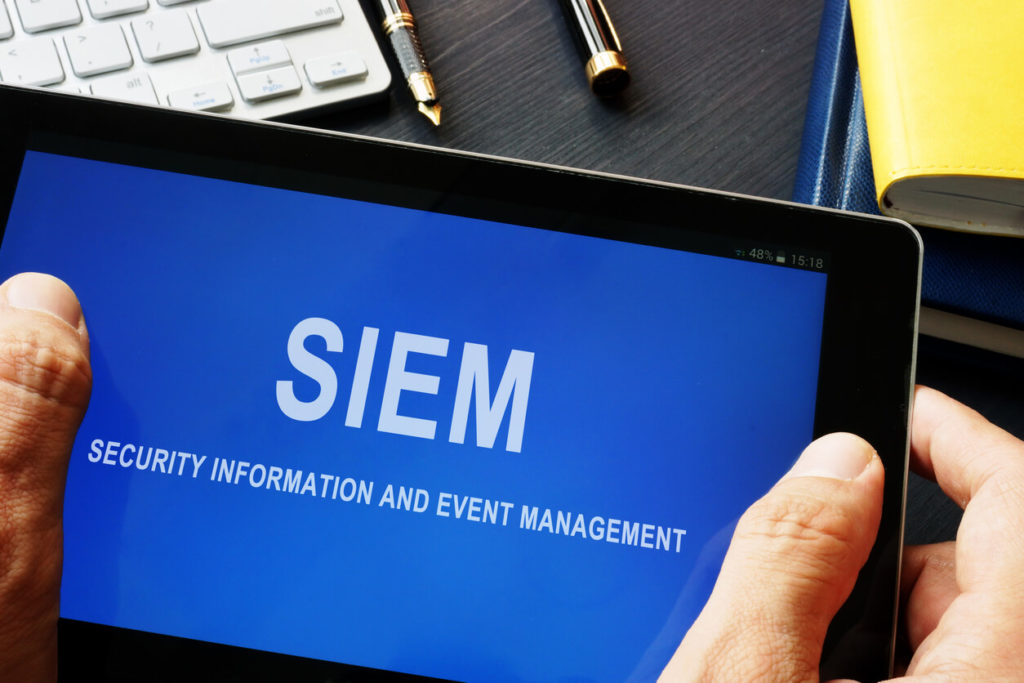
A security operations center (SOC) must rely on various tools to monitor, manage and control a digital environment to act as the first line of defense between an organization and malicious digital threats. While its arsenal may include various powerful software and hardware tools, few are as mission-critical as a security information and event management (SIEM) solution. But what is SIEM?
In this guide, we’ll discuss the purpose of SIEM technology, how SIEM works, why it matters and then discuss the top SIEM tools on the market.
What Is SIEM?
SIEM are software tools that security analysts on a SOC team can leverage to enhance their monitoring capabilities. It’s an amalgamation of security information management (SIM) and security event management (SEM) functions into one comprehensive system, capable of operating in either an on-premises or cloud environment.
SIEM tools sift through data, transforming it into actionable insights by identifying potential security issues and exposing vulnerabilities in the security perimeter before they can be exploited.
Such robust defenses empower security teams to act rather than react. In doing so, they can avoid the potentially costly ramifications of a successful data breach, such as business interruptions, fines, fees and reputational harm.
While SIEM is capable of dozens of tasks, it serves three primary purposes:
- Provides visibility and control over all of the assets within an organization’s environment
- Proactively detects advanced threats and abnormal activity
- Escalates security alerts so that the SOC can respond immediately to mitigate or eliminate any potential threats
Why Does SIEM Matter?
SIEM solutions provide real-time monitoring and analysis of security incidents while also tracking and logging security data – necessary for compliance and auditing purposes.
Even a small enterprise likely has troves of data. This automated response tool makes it easier for companies to manage and sift through that information and prioritize potential security threats.
SIEM is capable of detecting threats that might have otherwise flown under the radar, which, left unnoticed, would be free to infiltrate your security defenses silently.
Put simply, the faster you can identify a threat, the less damage it may cause. That’s why a SIEM solution is indispensable – it dramatically reduces the mean time to detect (MTTD) advanced persistent threats and the mean time to respond (MTTR) to those threats.
Although there are different types of SIEM, other advantages include:
- Improved regulatory compliance – SIEM software reduces risk by aligning your organization with regulatory compliance mandates like HIPAA, HITECH, PCI and GDPR. By automatically collecting, analyzing and documenting data flow, you free internal resources to focus on core competencies while meeting strict compliance reporting standards.
- Real-time visibility and threat recognition – SIEM tools create a holistic picture of your organization’s security posture across the entire environment. This creates improved communication and collaboration between departments and teams while reducing the time it takes to identify and respond to a threat.
- Improved organization – SIEM can centralize data storage, log file data and disparate systems. Log file management makes accessing and searching raw and parsed data easier.
- Multi-purpose – SIEM has several different use-cases, including troubleshooting, security programs and audit and compliance reporting
How Does SIEM Work?
SIEM solutions have been used for nearly two decades, but the technology has dramatically evolved. Today, practically all of the next-gen solutions offer the same core functionalities:
- Log management – A SIEM solution performs real-time collection, storage and search of log and flow data across various systems, devices, applications, assets, networks, users and cloud environments. By automatically gathering and centralizing this data, IT and security teams can more easily review it and act accordingly.
- Open source and scalable architecture – Next-gen solutions empower teams to streamline data across disparate systems, including mobile, on-premises and cloud environments.
- Incident monitoring and security alerts – SIEM can effectively monitor security incidents across an entire ecosystem by centralizing and identifying all entities within an IT environment. If an incident is flagged, system admins will be sent automated alerts. Furthermore, many systems allow IT teams to create custom rule sets and predefined actions should a specific incident or threat arise.
- User and Entity Behavior Analytics (UEBA) – This technology component uses machine learning and advanced algorithms to detect anomalies in user behavior, routers, servers and endpoints. It establishes a baseline behavior for users and entities, erecting profiles for how each would normally act regarding communication, download activity, application usage, etc.
It then creates statistical models that form the boundaries of the usual behavior. Then, if a user or entity deviates from their routine, the system automatically flags the activity as suspicious or anomalous.
- Compliance Management and Reporting – If you’re subject to various regulatory compliance matters, SIEM can be a valuable tool to collate and verify compliance data. These solutions can create real-time, automated compliance reports for different compliance standards, ranging from HIPAA to SOX.
Types of SIEM Tools
Enterprises must carefully consider the features of various SIEM tools on the market. For instance, questions you should first ask include:
- Does the system offer automation and built-in reporting for compliance purposes?
- Can you create customizable compliance reports?
- Can the system integrate with and give commands to other security controls?
- Does the system come with a particular threat intelligence feed, or can you determine that yourself?
- Does the system leverage AI and machine learning to improve its accuracy and performance continuously?
- Does the system provide forensic capabilities?
With that in mind, some of the more popular SIEM tools on the market include:
ELK Stack
A fantastic starter SIEM, ELK Stack is a free, highly rated open-source SIEM tool. It’s comprised of three primary projects:
- Elasticsearch – A search and analytics engine that enables the search of time-series data.
- Logstash – A server-side data processing pipeline that aggregates, analyzes and processes data across several sources.
- Kibana – A visual data organizer that provides charts and graphs that improve analysis.
This service is optimally used as a building block in a larger SIEM stack.
Splunk
If budget isn’t an issue, Splunk is an enterprise security powerhouse. This SIEM solution is a highly customizable technology solution that provides:
- User behavior analytics
- Log management
- Network traffic monitoring
- Threat intelligence
- Vulnerability scanning
Spunk’s security operation suite is compatible with Windows, Linux, macOS, FreeBSD, Solaris 11 and AIX.
OSSEC
As one of the best intrusion detection-based SIEM on the market, Open Source Security (OSSEC) is a suite of security tools that utilizes a host-based intrusion system. As a result, OSSEC can log and analyze data across multiple types of systems. But it can also be programmed to focus on intrusions within a specific operating system, such as Linux, macOS or Windows.
IBM QRadar
IBM’s QRadar is unique in that it can be deployed as software, hardware or a virtual appliance. It’s a flexible system that can adapt to a company’s specific needs and environment. QRadar is capable of:
- Identifying insider threats
- Detecting advanced threats
- Securing a cloud system
- Uncovering data exfiltration
- Compliance management
- Monitoring OT and IoT security
SIEM Implementation Best Practices
Do you plan on investing in a SIEM solution?
If so, here are some implementation best practices you should consider :
- Start by defining the scope of your SIEM deployment.
- Identify your goals and objectives, keeping your existing security protocols in mind.
- Roll it out in phases, testing iteratively to ensure it’s compatible and working as intended.
- Identify compliance requirements and compare them to your potential SIEM options.
- Stipulate your predefined data correlation rules and thresholds across the entire environment.
- Catalog all of your digital assets.
- Find the optimal balance in data collection so you have enough to gain a comprehensive view of the system but not so much that you’re flooded.
- Create a post-threat detection incident response plan.
- Appoint individuals responsible for the various phases of the incident response plan.
- Establish BYOD policies and restrictions.
Helixstorm—SIEM Solutions and So Much More
SIEM are valuable tools that companies can use to enhance their threat monitoring and detection protocols. But, if you want to keep your business safe in an evolving threat landscape, such tools are just one piece of the puzzle. They’re an essential component, no doubt, but you’ll need more than that to mount your defenses properly.
Enter Helixstorm. With our managed security operations, you get access to a custom information security plan that includes:
- A security operations center
- An event management SIEM
- Endpoint detection and response (EDR)
- Next-gen firewalls, among other powerful tools.
As a managed service provider, we offer round-the-clock support, network management and a security solution that can scale with your changing needs.
If you’re prepared to bolster your security defenses, schedule a meeting today.


